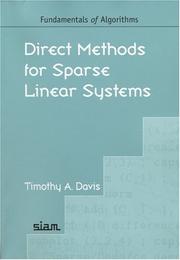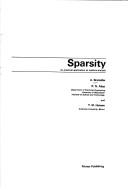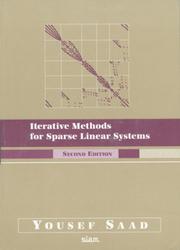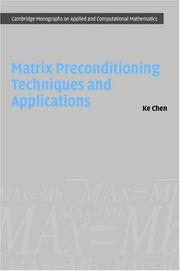| Listing 1 - 10 of 13 | << page >> |
Sort by
|
Book

ISBN: 9783110226157 9783110226140 Year: 2010 Publisher: Berlin Boston
Abstract | Keywords | Export | Availability | Bookmark
 Loading...
Loading...Choose an application
- Reference Manager
- EndNote
- RefWorks (Direct export to RefWorks)
The present collection is the very first contribution of this type in the field of sparse recovery. Compressed sensing is one of the important facets of the broader concept presented in the book, which by now has made connections with other branches such as mathematical imaging, inverse problems, numerical analysis and simulation. The book consists of four lecture notes of courses given at the Summer School on "Theoretical Foundations and Numerical Methods for Sparse Recovery" held at the Johann Radon Institute for Computational and Applied Mathematics in Linz, Austria, in September 2009. This unique collection will be of value for a broad community and may serve as a textbook for graduate courses. From the contents: "Compressive Sensing and Structured Random Matrices" by Holger Rauhut "Numerical Methods for Sparse Recovery" by Massimo Fornasier "Sparse Recovery in Inverse Problems" by Ronny Ramlau and Gerd Teschke "An Introduction to Total Variation for Image Analysis" by Antonin Chambolle, Vicent Caselles, Daniel Cremers, Matteo Novaga and Thomas Pock
Sparse matrices --- Equations --- Differential equations, Partial --- Numerical solutions --- Matrices éparses --- Equations aux dérivées partielles --- Solutions numériques
Book
ISBN: 0387941312 3540941312 1461383714 1461383692 Year: 1993 Publisher: New York (N.Y.) : Springer,
Abstract | Keywords | Export | Availability | Bookmark
 Loading...
Loading...Choose an application
- Reference Manager
- EndNote
- RefWorks (Direct export to RefWorks)
Graph theory --- Sparse matrices --- Congresses. --- Sparse matrices. --- Matrices éparses. --- Analyse numérique. --- Numerical analysis --- Graphes, Théorie des --- Analyse numérique --- Graphes, Théorie des --- Matrices éparses.
Book
ISBN: 9783110226140 Year: 2010 Publisher: Berlin : De Gruyter,
Abstract | Keywords | Export | Availability | Bookmark
 Loading...
Loading...Choose an application
- Reference Manager
- EndNote
- RefWorks (Direct export to RefWorks)
Sparse matrices --- Equations --- Differential equations, Partial --- Matrices éparses --- Equations --- Equations aux dérivées partielles --- Numerical solutions --- Numerical solutions --- Solutions numériques --- Solutions numériques

ISBN: 079231154X 9048140862 940171116X 9780792311546 Year: 1991 Volume: 65 Publisher: Dordrecht: Kluwer,
Abstract | Keywords | Export | Availability | Bookmark
 Loading...
Loading...Choose an application
- Reference Manager
- EndNote
- RefWorks (Direct export to RefWorks)
Sparse matrices --- Matrices éparses --- Data processing --- Informatique --- -519.6 --- 681.3*G13 --- Spare matrix techniques --- Matrices --- Computational mathematics. Numerical analysis. Computer programming --- Numerical linear algebra: conditioning; determinants; Eigenvalues; error analysis; linear systems; matrix inversion; pseudoinverses; sparse and very largesystems --- Data processing. --- 681.3*G13 Numerical linear algebra: conditioning; determinants; Eigenvalues; error analysis; linear systems; matrix inversion; pseudoinverses; sparse and very largesystems --- 519.6 Computational mathematics. Numerical analysis. Computer programming --- Matrices éparses --- 519.6 --- Sparse matrices - Data processing

ISBN: 9780898716139 0898716136 Year: 2006 Publisher: Philadelphia: Society for industrial and applied mathematics,
Abstract | Keywords | Export | Availability | Bookmark
 Loading...
Loading...Choose an application
- Reference Manager
- EndNote
- RefWorks (Direct export to RefWorks)
Sparse matrices --- Linear systems --- Matrices éparses --- Systèmes linéaires --- 519.61 --- 681.3*G13 --- Numerical methods of algebra --- Numerical linear algebra: conditioning; determinants; eigenvalues and eigenvectors; error analysis; linear systems; matrix inversion; pseudoinverses; singular value decomposition; sparse, structured, and very large systems (direct and iterative methods) --- 519.61 Numerical methods of algebra --- Matrices éparses --- Systèmes linéaires --- Spare matrix techniques --- Matrices --- Systems, Linear --- Differential equations, Linear --- System theory

ISBN: 0273009389 Year: 1976 Publisher: London Pitman
Abstract | Keywords | Export | Availability | Bookmark
 Loading...
Loading...Choose an application
- Reference Manager
- EndNote
- RefWorks (Direct export to RefWorks)
Mathematical control systems --- Numerical analysis --- Planning (firm) --- System analysis --- Equations, Simultaneous --- Sparse matrices --- Data processing. --- -Sparse matrices --- -System analysis --- -519.6 --- 681.3*G13 --- Network theory --- Systems analysis --- System theory --- Mathematical optimization --- Spare matrix techniques --- Matrices --- Simultaneous equations --- Data processing --- Computational mathematics. Numerical analysis. Computer programming --- Numerical linear algebra: conditioning; determinants; Eigenvalues; error analysis; linear systems; matrix inversion; pseudoinverses; sparse and very largesystems --- 681.3*G13 Numerical linear algebra: conditioning; determinants; Eigenvalues; error analysis; linear systems; matrix inversion; pseudoinverses; sparse and very largesystems --- 519.6 Computational mathematics. Numerical analysis. Computer programming --- Analyse de systèmes --- Matrices éparses --- Informatique --- Matrices éparses --- 519.6 --- Matrices éparses.

ISBN: 0898715342 9780898715347 Year: 2003 Publisher: Philadelphia PA: Society for industrial and applied mathematics,
Abstract | Keywords | Export | Availability | Bookmark
 Loading...
Loading...Choose an application
- Reference Manager
- EndNote
- RefWorks (Direct export to RefWorks)
Sparse matrices --- Iterative methods (Mathematics) --- Differential equations, Partial --- Matrices éparses --- Itération (Mathématiques) --- Equations aux dérivées partielles --- Numerical solutions --- Solutions numériques --- Sparse matrices. --- Numerical solutions. --- Iterative methods (Mathematics). --- Matrices éparses --- Itération (Mathématiques) --- Equations aux dérivées partielles --- Solutions numériques --- Numerical solutions of algebraic equations --- 519.61 --- 681.3*G13 --- -Iterative methods (Mathematics) --- Spare matrix techniques --- Iteration (Mathematics) --- Numerical methods of algebra --- Numerical linear algebra: conditioning; determinants; eigenvalues and eigenvectors; error analysis; linear systems; matrix inversion; pseudoinverses; singular value decomposition; sparse, structured, and very large systems (direct and iterative methods) --- 519.61 Numerical methods of algebra --- Matrices --- Numerical analysis --- Partial differential equations --- Differential equations, Partial - Numerical solutions

ISBN: 0521838282 9780521838283 9780511543258 051111558X 9780511115585 0511115032 9780511115035 0511543255 1107150590 9781107150591 1280434805 9781280434808 9786610434800 6610434808 0511181930 9780511181931 051119904X 051129980X Year: 2005 Volume: 19 Publisher: Cambridge ; New York : Cambridge University Press,
Abstract | Keywords | Export | Availability | Bookmark
 Loading...
Loading...Choose an application
- Reference Manager
- EndNote
- RefWorks (Direct export to RefWorks)
Preconditioning techniques have emerged as an essential part of successful and efficient iterative solutions of matrices. Ke Chen's book offers a comprehensive introduction to these methods. A vast range of explicit and implicit sparse preconditioners are covered, including the conjugate gradient, multi-level and fast multi-pole methods, matrix and operator splitting, fast Fourier and wavelet transforms, incomplete LU and domain decomposition, Schur complements and approximate inverses. In addition, aspects of parallel realization using the MPI are discussed. Very much a users-guide, the book provides insight to the use of these techniques in areas such as acoustic wave scattering, image restoration and bifurcation problems in electrical power stations. Supporting MATLAB files are available from the Web to support and develop readers' understanding, and provide stimulus for further study. Pitched at graduate level, the book is intended to serve as a useful guide and reference for students, computational practitioners, engineers and researchers alike.
Matrices --- Differential equations --- Iterative methods (Mathematics) --- Integral equations --- Sparse matrices --- Equations différentielles --- Itération (Mathématiques) --- Equations intégrales --- Matrices éparses --- Numerical solutions --- Data processing --- Solutions numériques --- Informatique --- data processing --- Spare matrix techniques --- Equations, Integral --- Functional equations --- Functional analysis --- Iteration (Mathematics) --- Numerical analysis --- Data processing. --- 517.91 Differential equations --- Equations différentielles --- Itération (Mathématiques) --- Equations intégrales --- Matrices éparses --- Solutions numériques --- 517.91 --- Numerical solutions&delete& --- Sparse matrices - data processing --- Differential equations - Numerical solutions - Data processing --- Iterative methods (Mathematics) - Data processing --- Integral equations - Numerical solutions - Data processing
Book
ISBN: 9789812833648 9789812833631 9812833641 9812833633 9786612441417 1282441418 981283365X 9789812833655 Year: 2008 Volume: 1 Publisher: Singapore ; Hackensack, NJ : World Scientific,
Abstract | Keywords | Export | Availability | Bookmark
 Loading...
Loading...Choose an application
- Reference Manager
- EndNote
- RefWorks (Direct export to RefWorks)
Harry M Markowitz received the Nobel Prize in Economics in 1990 for his pioneering work in portfolio theory. He also received the von Neumann Prize from the Institute of Management Science and the Operations Research Institute of America in 1989 for his work in portfolio theory, sparse matrices and the SIMSCRIPT computer language. While Dr Markowitz is well-known for his work on portfolio theory, his work on sparse matrices remains an essential part of linear optimization calculations. In addition, he designed and developed SIMSCRIPT - a computer programming language. SIMSCRIPT has been widely
Investment analysis. --- Portfolio management. --- Sparse matrices. --- Analyse financière --- Gestion de portefeuille --- Matrices éparses --- Portfolio management --- -Investment analysis --- -Sparse matrices --- -330.9 --- Spare matrix techniques --- Matrices --- Analysis of investments --- Analysis of securities --- Security analysis --- Investment management --- Investment analysis --- Investments --- Securities --- Electronic information resources --- E-books --- AA / International- internationaal --- 305.91 --- 339.4 --- Econometrie van de financiële activa. Portfolio allocation en management. CAPM. Bubbles. --- Vermogensbeheer. Financiële analyse. Verspreiding van de beleggingsrisico's. --- Analyse financière --- Matrices éparses --- Sparse matrices --- Econometrie van de financiële activa. Portfolio allocation en management. CAPM. Bubbles --- Vermogensbeheer. Financiële analyse. Verspreiding van de beleggingsrisico's
Book
ISBN: 0131652745 9780131652743 Year: 1981 Publisher: Englewood Cliffs: Prentice Hall,
Abstract | Keywords | Export | Availability | Bookmark
 Loading...
Loading...Choose an application
- Reference Manager
- EndNote
- RefWorks (Direct export to RefWorks)
Numerical solutions of algebraic equations --- Sparse matrices --- FORTRAN (Computer program language) --- Matrices éparses --- FORTRAN (Langage de programmation) --- Data processing. --- Informatique --- data processing --- #TCPW N2.0 --- 519.6 --- 681.3*G --- 681.3*G13 --- Computational mathematics. Numerical analysis. Computer programming --- Mathematics of computing --- Numerical linear algebra: conditioning; determinants; Eigenvalues; error analysis; linear systems; matrix inversion; pseudoinverses; sparse and very largesystems --- 681.3*G13 Numerical linear algebra: conditioning; determinants; Eigenvalues; error analysis; linear systems; matrix inversion; pseudoinverses; sparse and very largesystems --- 681.3*G Mathematics of computing --- 519.6 Computational mathematics. Numerical analysis. Computer programming --- Matrices éparses --- Spare matrix techniques --- Matrices --- Formula Translation (Computer program language) --- Programming languages (Electronic computers) --- Data processing --- Sparse matrices - data processing
| Listing 1 - 10 of 13 | << page >> |
Sort by
|

 Search
Search Feedback
Feedback About UniCat
About UniCat  Help
Help News
News